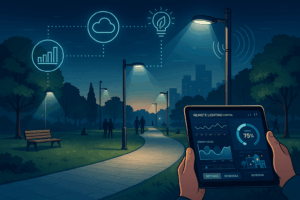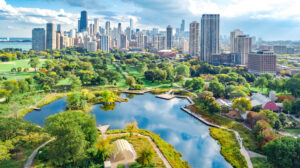Smart lighting is transforming public spaces by creating environments that are safer, more efficient, and sustainable. Whether it’s enhancing visibility, reducing costs, or cutting emissions, this next-gen technology is proving to be an essential upgrade for parks and recreational facilities. With features like adaptive controls and energy-efficient LEDs, smart lighting is making parks brighter, smarter, and greener.
Here’s why parks and municipalities are switching to smart lighting and how it’s revolutionizing public spaces.
The Growing Demand for Smart Lighting in Parks & Recreation
Outdated lighting systems are quickly becoming a thing of the past. Communities now expect more from public spaces, and traditional lighting is falling short in several key areas.
- Safety is critical. Poorly lit areas can deter visitors and even pose risks, while well-lit spaces create a sense of security and comfort.
- Energy efficiency is now non-negotiable. Rising energy costs and environmental concerns have pushed cities to prioritize upgrades like smart city lighting solutions to cut waste.
- The experience matters. Smart lighting can maximize both utility and enjoyment for visitors, ensuring parks remain vibrant and welcoming after dark.
This growing demand for park lighting upgrades is fueled by the need to meet modern standards while reducing costs and enhancing sustainability.
Key Benefits of Smart Lighting for Parks and Recreational Spaces
Enhanced Safety & Security in Public Spaces
- Brightness adapts to real-time activity, ensuring walking trails, play areas, and event spaces are always appropriately lit.
- Remote lighting control lets staff make instant adjustments from anywhere.
- Emergency overrides allow quick responses to security needs.
With these capabilities, park lighting upgrades don’t just light up parks; they create environments where visitors feel secure and welcome.
Reduced Energy Consumption & Operational Costs
- Automated schedules ensure lights are only on when they’re actually needed, reducing electricity use during off-peak hours.
- Motion sensors prevent waste by illuminating areas only when visitors are present.
- Energy-efficient outdoor lighting reduces overall consumption, helping municipalities save on energy bills while staying environmentally friendly.
Parks that implement smart systems not only lower their costs but also free up funds for reinvestment into other community projects.
Remote Monitoring & Automation for Efficient Management

- Centralized dashboards allow facility managers to control lighting across multiple locations without leaving their office.
- Real-time alerts notify staff of outages or maintenance needs, reducing downtime.
- Adjustments can be made remotely, saving time and eliminating unnecessary site visits.
This kind of efficient management makes public spaces easier to maintain and ensures they remain enjoyable for visitors.
Sustainability & Environmental Benefits
- Energy-efficient LEDs slash energy consumption, reducing carbon footprints.
- Reduced light pollution protects wildlife while maintaining the natural beauty of the area.
- Aligning with sustainable lighting for parks initiatives supports broader citywide efforts to promote eco-friendly alternatives.
By implementing smart lighting, cities can align their parks with larger sustainability goals while improving functionality.
Smart Lighting Technologies Transforming Parks & Recreation
IoT-Powered Smart Controllers for Real-Time Adjustments
Using Internet of Things (IoT) tech, these systems offer next-level control:
- Sensors adapt lights to weather, foot traffic, and events.
- Data insights allow for fine-tuning, leading to maximum efficiency.
These features put Smart City Lighting Solutions on the cutting edge of innovation.
Adaptive Lighting for Multi-Purpose Use
Every park has different needs, and adaptive lighting handles them with ease:
- Brighten walking paths during high-traffic morning runs, then dim for quieter evening strolls.
- Customize lighting for zones, like soft light for picnic spots or brighter lights for sports fields.
With Energy-Efficient Outdoor Lighting and Smart Lighting Systems, you get precision that traditional setups just can’t offer.
Integration with Other Smart City Systems
Modern parks aren’t just about fun amenities; they’re part of a connected smart city network. Smart lighting integrates seamlessly with:
- Security cameras and emergency systems for added safety.
- Automated reporting tools to monitor performance and compliance.
With Remote Lighting Control, parks don’t just light up; they become an integral part of a high-tech ecosystem.
How Parks & Municipalities Can Implement Smart Lighting
Getting started with park lighting upgrades isn’t as daunting as it may sound. First, assess the current infrastructure to identify gaps or areas of improvement. Then, choose a system that fits the unique needs of your park, whether it’s motion-sensing lights for trails or fully integrated systems for larger recreational complexes. Finally, plan the rollout step-by-step, ensuring installation is smooth and staff are trained to operate the new systems.
Real-World Examples of Smart Lighting in Action
Cities and parks worldwide are already reaping the benefits of energy-efficient outdoor lighting. 
For example, Chicago Park District is still completing ongoing efforts to convert park lighting fixtures to energy–efficient LED bulbs. The Districy has already converted 41% of its light fixtures and over 100 park fieldhouses indoor fixtures.
Another one is Los Angeles. The city replaced 150,000+ streetlights with LEDs, cutting energy use by 63% and saving $10M annually. The project also reduced nighttime traffic collisions by 60% and improved public safety. Next, the city plans to expand smart lighting for air quality monitoring, EV charging, and smart parking.
These success stories serve as inspiration for other parks and cities considering their own upgrades.
The Future of Smart Lighting for Parks & Recreation
The smart lighting revolution is far from over, and innovation continues to push the boundaries of what’s possible. AI-powered systems are on the horizon, offering predictive maintenance to prevent outages before they occur. Solar-powered solutions will make smart lighting accessible even in off-grid locations. And as smart infrastructure expands, lighting will become even more integrated into connected public space networks.
There’s no question that smart city lighting solutions will play a vital role in shaping tomorrow’s parks.
Upgrade Your Parks with Smart Lighting Today
Smart lighting represents more than just technology; it’s an investment in safety, sustainability, and long-term value for your community. With remote lighting control and energy-efficient innovations, you’re not just upgrading your parks; you’re future-proofing them. Contact us to learn more about implementing smart lighting in your community!
